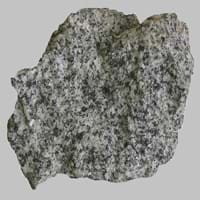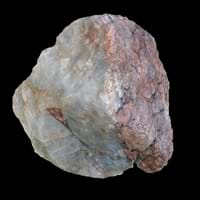Definition
Diorite is a grey to dark-grey intermediate intrusive igneous rock composed principally of plagioclase feldspar,biotite, hornblende, and pyroxene
Pegmatite rock is a holocrystalline, intrusive igneous rock which is composed of interlocking phaneritic crystals
Discoverer
Unknown
R. J. Hauy
Etymology
From early 19th century coined in French, formed irregularly from Greek diorizein distinguish
From Greek pegma, pegmat which means- thing joined together + -ite
Class
Igneous Rocks
Igneous Rocks
Sub-Class
Durable Rock, Hard Rock
Durable Rock, Hard Rock
Other Categories
Coarse Grained Rock, Medium Grained Rock, Opaque Rock
Coarse Grained Rock, Opaque Rock
Texture
Phaneritic
Pegmatitic
Color
Black, Brown, Light to Dark Grey, White
Black, Brown, Cream, Green, Grey, Pink, Red, Rust, Silver, White, Yellow
Durability
Durable
Durable
Appearance
Shiny
Layered, Banded, Veined and Shiny
Interior Uses
Decorative Aggregates, Interior Decoration
Decorative Aggregates, Flooring, Interior Decoration
Exterior Uses
As Building Stone, As Facing Stone, Garden Decoration
As Building Stone, As Facing Stone, Paving Stone
Other Architectural Uses
Curbing
Curbing
Construction Industry
As Dimension Stone, Cement Manufacture, Cobblestones, Construction Aggregate, for Road Aggregate
As Dimension Stone, Building houses or walls, Construction Aggregate, for Road Aggregate, Landscaping
Medical Industry
Not Yet Used
Not Yet Used
Antiquity Uses
Artifacts, Monuments, Sculpture, Small Figurines
Artifacts, Sculpture, Small Figurines
Commercial Uses
Creating Artwork, Curling
Creating Artwork, Jewelry, Source of corundum, tourmalines, beryls and topaz
Types
Not Available
Granite Pegmatite, Gabbro Pegmatite and Diorite Pegmatite
Features
Typically speckled black and white.
Generally rough to touch, Is one of the oldest rock, Source of corundum, tourmalines, beryls and topaz
Archaeological Significance
Monuments
Used
Not Yet Used
Famous Monuments
Data Not Available
Not Applicable
Famous Sculptures
Data Not Available
Data Not Available
Pictographs
Not Used
Not Used
Petroglyphs
Not Used
Not Used
Formation
Diorite is a coarse-grained intrusive igneous rock which contains large interlocking and randomly oriented crystals and forms when molten lava does not reach the Earth’s surface and cools down in the Earth’s crust.
Pegmatite rock is holocrystalline, intrusive igneous rock which is formed by partial melting and dewatering during the process of metamorphism.
Mineral Content
Albite, Amphibole, Apatite, Biotite, Feldspar, Hornblade, Ilmenite, Magnetite, Muscovite or Illite, Olivine, Plagioclase, Pyroxene, Quartz, Sulfides, Titanite, Zircon
Apatite, Beryl, Feldspar, Fluorite, Garnet, Lepidolite, Quartz, Silica, Spodumene, Topaz
Compound Content
Silicon Dioxide
Aluminium Oxide, CaO, Iron(III) Oxide, FeO, Potassium Oxide, Magnesium Carbonate, MgO, Phosphorus Pentoxide
Types of Metamorphism
Cataclastic Metamorphism, Contact Metamorphism, Regional Metamorphism
Burial Metamorphism, Cataclastic Metamorphism, Contact Metamorphism, Hydrothermal Metamorphism, Impact Metamorphism, Regional Metamorphism
Types of Weathering
Biological Weathering, Chemical Weathering, Mechanical Weathering
Biological Weathering, Chemical Weathering, Mechanical Weathering
Types of Erosion
Chemical Erosion, Coastal Erosion, Water Erosion
Chemical Erosion, Coastal Erosion, Glacier Erosion, Sea Erosion, Water Erosion, Wind Erosion
Grain Size
Medium to Coarse Grained
Medium to Coarse Grained
Fracture
Not Available
Conchoidal
Streak
Bluish Black
White
Porosity
Very Less Porous
Less Porous
Luster
Shiny
Grainy, Pearly and Vitreous
Cleavage
Not Available
Perfect
Specific Gravity
2.8-3
2.6-2.63
Transparency
Opaque
Translucent to Opaque
Density
2.8-3 g/cm3
2.6-2.65 g/cm3
Resistance
Heat Resistant, Pressure Resistant, Wear Resistant
Heat Resistant, Impact Resistant, Pressure Resistant
Deposits in Eastern Continents
Asia
Not Yet Found
China, India, Iran, Japan, Nepal, North Korea, Russia, Saudi Arabia, South Korea
Africa
Egypt
South Africa
Europe
Finland, Germany, Italy, Romania, Sweden, Turkey, United Kingdom
Austria, France, Greece, Ireland, Italy, Netherlands, Slovakia, Spain, Turkey, Ukraine
Others
Not Yet Found
Not Yet Found
Deposits in Western Continents
South America
Argentina, Bolivia, Chile, Colombia, Ecuador, Peru
Brazil
Deposits in Oceania Continent
Australia
New Zealand, Western Australia
New South Wales, Queensland, South Australia, Western Australia
All about Diorite and Pegmatite Properties
Know all about Diorite and Pegmatite properties here. All properties of rocks are important as they define the type of rock and its application. Diorite and Pegmatite belong to Igneous Rocks.Texture of Diorite is Phaneritic whereas that of Pegmatite is Pegmatitic. Diorite appears Shiny and Pegmatite appears Layered, Banded, Veined and Shiny. The luster of Diorite is shiny while that of Pegmatite is grainy, pearly and vitreous. Diorite is available in black, brown, light to dark grey, white colors whereas Pegmatite is available in black, brown, cream, green, grey, pink, red, rust, silver, white, yellow colors. The commercial uses of Diorite are creating artwork, curling and that of Pegmatite are creating artwork, jewelry, source of corundum, tourmalines, beryls and topaz.










